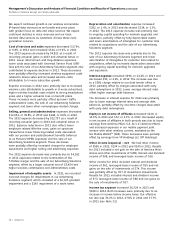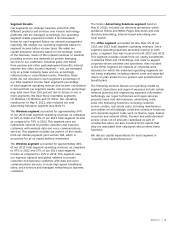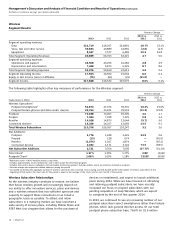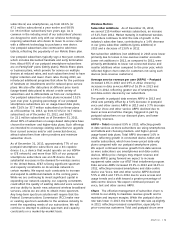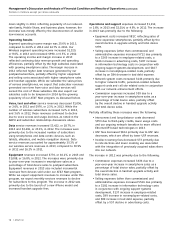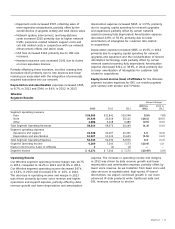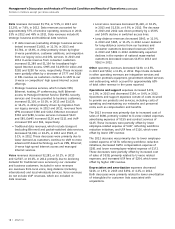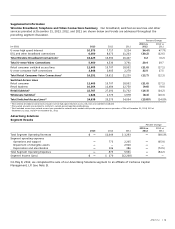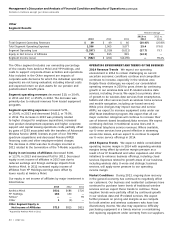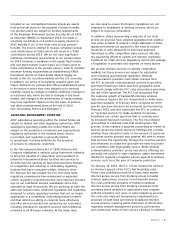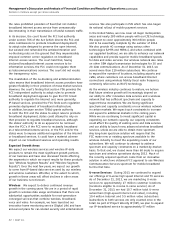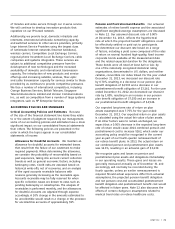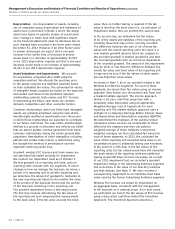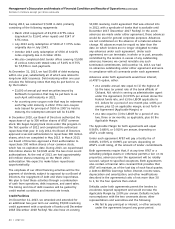AT&T Wireless 2013 Annual Report Download - page 24
Download and view the complete annual report
Please find page 24 of the 2013 AT&T Wireless annual report below. You can navigate through the pages in the report by either clicking on the pages listed below, or by using the keyword search tool below to find specific information within the annual report.
Management’s Discussion and Analysis of Financial Condition and Results of Operations (continued)
Dollars in millions except per share amounts
22 | AT&T Inc.
services. We also participate in ISIS which has also begun
its national rollout of mobile payment services.
In the United States, we now cover all major metropolitan
areas and nearly 280 million people with our LTE technology.
We expect to cover approximately 300 million people
and to be essentially complete by the summer of 2014.
We also provide 4G coverage using various other
technologies (UMTS and HSPA+), and when combined with
our upgraded backhaul, we are able to enhance our network
capabilities and provide superior mobile broadband speeds
for data and video services. Our wireless network also relies
on other GSM digital transmission technologies for 3G and
2G data communications. As of December 31, 2013, we
served more than 110 million subscribers. We continue
to expand the number of locations, including airports and
cafés, where customers can access broadband Internet
connections using wireless fidelity (local radio frequency
commonly referred to as Wi-Fi) technology.
As the wireless industry continues to mature, we believe
that future wireless growth will increasingly depend on
our ability to offer innovative data services and a wireless
network that has sufficient spectrum and capacity to
support these innovations. We are facing significant
spectrum and capacity constraints on our wireless network
in certain markets. We expect such constraints to increase
and expand to additional markets in the coming years.
While we are continuing to invest significant capital in
expanding our network capacity, our capacity constraints
could affect the quality of existing voice and data services
and our ability to launch new, advanced wireless broadband
services, unless we are able to obtain more spectrum.
Any long-term spectrum solution will require that the
FCC make new or existing spectrum available to the
wireless industry to meet the expanding needs of our
subscribers. We will continue to attempt to address
spectrum and capacity constraints on a market-by-market
basis. To that end, we closed more than 60 deals to acquire
spectrum and wireless operations during 2013. Much of
the recently acquired spectrum came from an innovative
solution in which we obtained FCC approval to use Wireless
Communication Services spectrum for mobile broadband
for the first time.
U-verse Services During 2013, we continued to expand
our offerings of U-verse high speed Internet and TV services.
As of December 31, 2013, we are marketing U-verse
services to approximately 27 million customer locations
(locations eligible to receive U-verse service). As of
December 31, 2013, we had 10.7 million total U-verse
subscribers (high-speed Internet and video), including
10.4 million Internet and 5.5 million video subscribers
(subscribers to both services are only counted once in the
total). As part of Project Velocity IP (VIP), we plan to expand
our IP-broadband service to approximately 57 million
the rules prohibited providers of fixed (but not mobile)
broadband Internet access service from unreasonably
discriminating in their transmission of lawful network traffic.
In its decision, the court found the FCC had authority
under section 706 of the Act (which directs the FCC and
state commissions to promote broadband deployment)
to adopt rules designed to preserve the open Internet,
but vacated and remanded the antidiscrimination and
no-blocking rules on the ground that they impermissibly
imposed common carrier regulation on broadband
Internet access service. The court held that, having
declared broadband Internet access services to be
information services, the FCC could not regulate them
as telecommunications services. The court did not vacate
the transparency rules.
The invalidation of the no-blocking and antidiscrimination
rules means that broadband Internet access providers have
greater flexibility in their provision of mass market services.
However, the court’s finding that section 706 provides the
FCC independent authority to adopt rules to promote
broadband deployment appears to give the FCC broad
authority to regulate the Internet and, more generally,
IP-based services, provided the FCC finds such regulation
promotes deployment of broadband infrastructure.
In addition, because section 706(a) grants authority
to both the FCC and the states to adopt rules to promote
broadband deployment, states could attempt to rely on
that provision to regulate broadband services, although
the states’ authority to do so appears to be narrower
than the FCC’s. If the FCC were to reclassify broadband
as a telecommunications service, or the FCC and/or the
states were to impose additional regulation of the Internet
or broadband services, it could have a material adverse
impact on our broadband services and operating results.
Expected Growth Areas
We expect our wireless services and wireline IP-data
products to remain the most significant growth portions
of our business and have also discussed trends affecting
the segments in which we report results for these products
(see “Wireless Segment Results” and “Wireline Segment
Results”). Over the next few years, we expect our growth
to come from IP-based data services used by our wireless
and wireline customers. Whether, or the extent to which,
growth in these areas will offset declines in other areas
of our business is not known.
Wireless We expect to deliver continued revenue
growth in the coming years. We are in a period of rapid
growth in wireless data usage and believe that there are
substantial opportunities available for next-generation
converged services that combine wireless, broadband,
voice and video. For example, we have launched our
innovative home monitoring service (Digital Life) and have
announced plans for car-related security and entertainment


